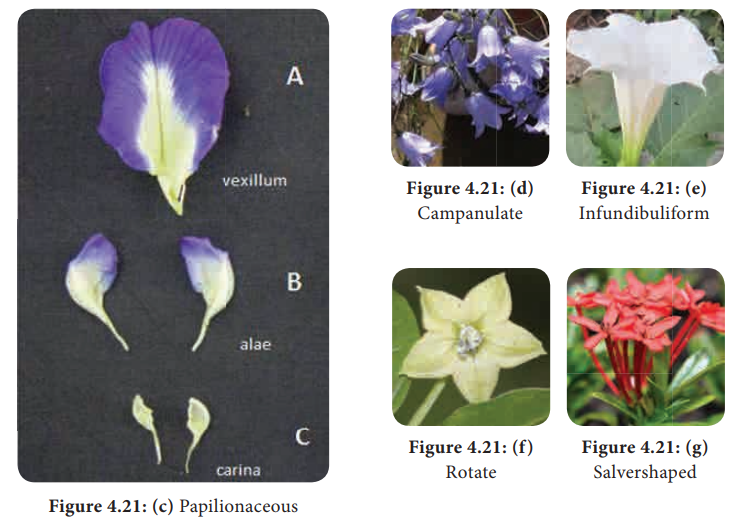What, Shapes, Fusion | Flower | Botany - Corolla | 11th Botany : Chapter 4 : Reproductive Morphology of Angiosperm
Chapter: 11th Botany : Chapter 4 : Reproductive Morphology of Angiosperm
Corolla

What is the use of pappus ?
Corolla
Corolla is the most attractive part in majority of
the flowers and is usually brightly coloured. Corolla helps to display the flower
and attracts the pollinators.
1. Fusion:
a. Apopetalous
(polypetalous, choripetalous): Petals are distinct. Example: Hibiscus.
b. Sympetalous
(gamopetalous): Petals are
fused. Example: Datura.
2. Shapes of corolla
I. Apopetalous Actinomorphic
1. Cruciform: Four
petals arranged in the form of a
cross. Example: Brassica, mustard,
radish, cauliflower.
2. Caryophyllaceous:
Five
petals with long claws with limb at
right angles to the claw. Example: Caryophyllaceae. Dianthus.
3. Rosaceous: Five to
many sessile or minutely clawed
petals with radiating limbs. Example: Rose, Tea.

II. Apopetalous Zygomorphic
Papilionaceous:
Made up of five distinct petals organized in a
butterfly shape. Corolla has three types of petals. One usually large posterior
petal called vexillum(standard)two
lateral petals-wings (alae) and two
anterior sympetalous petals called carina.
Example: Clitoria ternatea, Pea, Bean.

III. Sympetalous Actinomorphic
1.
Tubular:
Petals united to form a narrow tubular structure
with very short limbs. Example: Disc floret of sunflower.
2.
Campanulate:
Petals fused to form a bell-shaped corolla.
Example: Physalis,Cucurbita maxima, Campanula.
3.
Infundibuliform:
Petals fused to form funnel-shaped corolla. Tube
gradually widens into limbs. Example: Datura,
Ipomoea.

4. Rotate:
Petals fused to form a wheel shaped corolla with
very short tube and a spreading circular limb. Example: brinjal, Evolvulus
5. Salver
shaped or Hypocrateriform;
Petals fused to form a long narrow tube with spreading limbs. Example: Catharanthus, Ixora, Tabernaemontana

6.
Urceolate:
Petals fused to form urn-shaped or pot-shaped corolla.Example: Bryophyllum calycinum, Diospyros.
IV. Sympetalous Zygomorphic
1.
Bilabiate:
Corolla with two lips. Example: Ocimum,Leucas,Adhatoda.
Tubular corolla with a single strap-shaped limb.
Example: Ray floret of Helianthus
2.
Personate:
Corolla made up of two lips with the upper arched
and the lower protruding into the corolla throat. Example: Antirrhinum,Linaria.
3.
Ligulate:
Tubular corolla with a single strap-shaped limb.
Example: Ray floret of Helianthus.

Related Topics